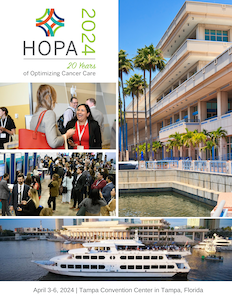Back
Trainee Research
Category: Quality Improvement
(092) Evaluation of Direct Oral Anticoagulant Eligibility and Prescribing for Primary VTE Prevention in High-Risk Ambulatory Cancer Patients
Friday, April 5, 2024
12:00 PM – 2:00 PM ET
.jpg)
Michelle Ann A. Wasan, PharmD (she/her/hers)
PGY2 Oncology Pharmacy Resident
The Johns Hopkins Hospital
Baltimore, Maryland, United States
Presenting Author(s)
Poster Abstract:
Background: Venous thromboembolism (VTE) significantly impacts morbidity and mortality in patients with active cancer.(1) Primary thromboprophylaxis is recommended for other high-risk conditions such as major surgery.(2) However, thromboprophylaxis in high-risk ambulatory cancer patients has not been routinely used due to the limitations of parenteral anticoagulants. Venous thromboembolism in cancer patients can disrupt or delay treatment, potentially worsening outcomes.(3) Long-term effects of VTE, such as post-thrombotic syndrome and chronic thromboembolic pulmonary hypertension, can diminish quality of life and impose substantial financial burdens.(2)
In recent years, direct oral anticoagulants (DOACs) have demonstrated benefits for primary VTE prevention in patients with cancer at intermediate to high risk for VTE. The AVERT and CASSINI trials have shown promise in identifying patients who may benefit from DOAC use for primary VTE prophylaxis and ultimately led to changes in national treatment guidelines for cancer-associated thrombosis.(2,4) Both the National Comprehensive Cancer Network and American Society of Clinical Oncology guidelines now include apixaban and rivaroxaban as recommended oral thromboprophylaxis options in ambulatory cancer patients at risk for VTE (defined by Khorana score of 2 or higher prior to start of systemic therapy) for up to 6 months or longer if VTE risk persists.
Objective: The purpose of this study is to characterize DOAC eligibility and prescribing patterns for primary VTE prophylaxis in high-risk ambulatory cancer patients diagnosed with lung or pancreatic cancer at The Johns Hopkins Hospital (JHH), Johns Hopkins Bayview Medical Center (JHBMC), and Sibley Memorial Hospital (SMH).
Methods: This multi-site retrospective cohort study within a single health system will evaluate adult patients with newly diagnosed pancreatic or lung cancer followed at JHH, JHBMC, or SMH between January 1, 2022 to December 31, 2022. The primary outcome is the proportion of ambulatory patients with lung or pancreatic cancer eligible for DOAC primary VTE prophylaxis. Secondary outcomes include the proportion of patients prescribed a DOAC, rate of VTE and bleeding events, and the frequency of thrombocytopenia in VTE prophylaxis-eligible patients.
Result/
Conclusion: The goal of this study is to identify opportunities to improve outcomes and adherence to national guidelines recommending primary VTE prophylaxis in eligible high-risk ambulatory cancer patients within a single health system.
References (must also be included in final poster): 1. Donnellan E, Khorana AA. Cancer and Venous Thromboembolic Disease: A Review. Oncologist. 2017;22(2):199-207.
2. Khorana, Alok A et al. “Rivaroxaban for Thromboprophylaxis in High-Risk Ambulatory Patients with Cancer.” The New England journal of medicine vol. 380,8 (2019): 720-728.
3. Mulder, Frits I et al. “Primary Thromboprophylaxis in Ambulatory Cancer Patients: Where Do We Stand?.” Cancers vol. 12,2 367 (2020).
4. Carrier, Marc et al. “Apixaban to Prevent Venous Thromboembolism in Patients with Cancer.” The New England journal of medicine vol. 380,8 (2019): 711-719
Background: Venous thromboembolism (VTE) significantly impacts morbidity and mortality in patients with active cancer.(1) Primary thromboprophylaxis is recommended for other high-risk conditions such as major surgery.(2) However, thromboprophylaxis in high-risk ambulatory cancer patients has not been routinely used due to the limitations of parenteral anticoagulants. Venous thromboembolism in cancer patients can disrupt or delay treatment, potentially worsening outcomes.(3) Long-term effects of VTE, such as post-thrombotic syndrome and chronic thromboembolic pulmonary hypertension, can diminish quality of life and impose substantial financial burdens.(2)
In recent years, direct oral anticoagulants (DOACs) have demonstrated benefits for primary VTE prevention in patients with cancer at intermediate to high risk for VTE. The AVERT and CASSINI trials have shown promise in identifying patients who may benefit from DOAC use for primary VTE prophylaxis and ultimately led to changes in national treatment guidelines for cancer-associated thrombosis.(2,4) Both the National Comprehensive Cancer Network and American Society of Clinical Oncology guidelines now include apixaban and rivaroxaban as recommended oral thromboprophylaxis options in ambulatory cancer patients at risk for VTE (defined by Khorana score of 2 or higher prior to start of systemic therapy) for up to 6 months or longer if VTE risk persists.
Objective: The purpose of this study is to characterize DOAC eligibility and prescribing patterns for primary VTE prophylaxis in high-risk ambulatory cancer patients diagnosed with lung or pancreatic cancer at The Johns Hopkins Hospital (JHH), Johns Hopkins Bayview Medical Center (JHBMC), and Sibley Memorial Hospital (SMH).
Methods: This multi-site retrospective cohort study within a single health system will evaluate adult patients with newly diagnosed pancreatic or lung cancer followed at JHH, JHBMC, or SMH between January 1, 2022 to December 31, 2022. The primary outcome is the proportion of ambulatory patients with lung or pancreatic cancer eligible for DOAC primary VTE prophylaxis. Secondary outcomes include the proportion of patients prescribed a DOAC, rate of VTE and bleeding events, and the frequency of thrombocytopenia in VTE prophylaxis-eligible patients.
Result/
Conclusion: The goal of this study is to identify opportunities to improve outcomes and adherence to national guidelines recommending primary VTE prophylaxis in eligible high-risk ambulatory cancer patients within a single health system.
References (must also be included in final poster): 1. Donnellan E, Khorana AA. Cancer and Venous Thromboembolic Disease: A Review. Oncologist. 2017;22(2):199-207.
2. Khorana, Alok A et al. “Rivaroxaban for Thromboprophylaxis in High-Risk Ambulatory Patients with Cancer.” The New England journal of medicine vol. 380,8 (2019): 720-728.
3. Mulder, Frits I et al. “Primary Thromboprophylaxis in Ambulatory Cancer Patients: Where Do We Stand?.” Cancers vol. 12,2 367 (2020).
4. Carrier, Marc et al. “Apixaban to Prevent Venous Thromboembolism in Patients with Cancer.” The New England journal of medicine vol. 380,8 (2019): 711-719

